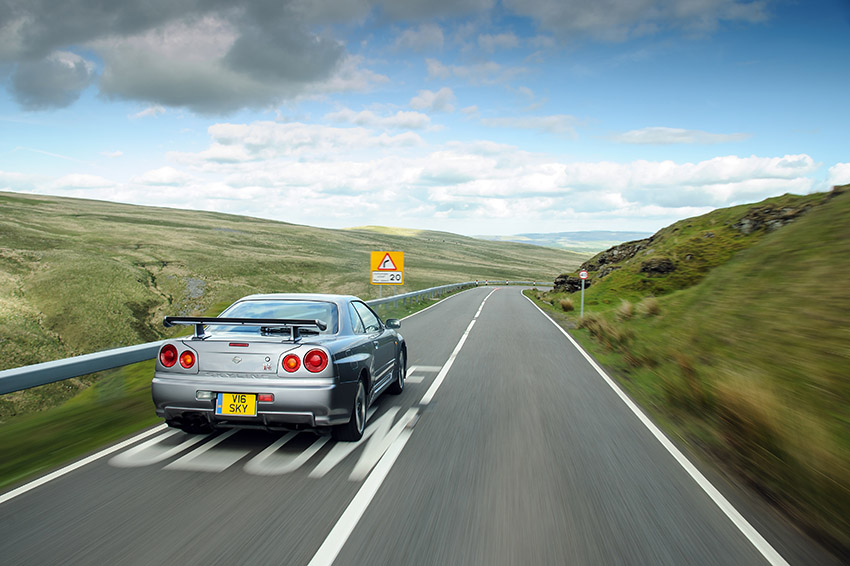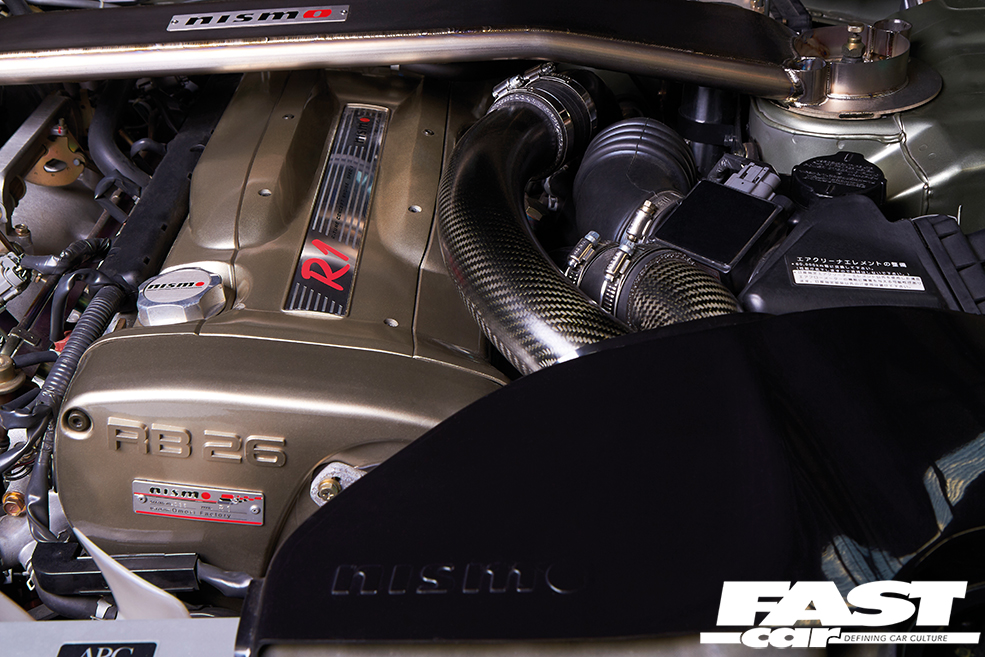The Nissan Skyline GT-R R34 has a cultural status which few other cars can match, and for many, it’s the holy grail of JDM. If you can afford one, here’s what to look out for.
If there was one common gripe that people had about the R33 Skyline, it was its dimensions. Nissan had opted for a longer-wheelbase approach with the R32’s successor, but many misunderstood that as the Skyline ‘going soft’. So, to appease enthusiasts, the Nissan Skyline GT-R R34 more closely resembled the blocky, angular lines of the R32 Skyline GT-R. From an aesthetic point of view, that was no bad thing, and it also resulted in some creative aerodynamic solutions.
The front bumper, for example, has vents which guide airflow around either side. Underneath there are carbon fiber panels to create an even surface. When these elements are combined, the front end of the R34 has a lift co-efficient of just 0.1. In non-geek speak, that means it stays planted at high speed.
There were several other core revisions made to the car too. Brembo, for instance, brought bigger brake rotors and chunkier calipers into the mix. While Getrag added a sixth gear to the transmission.
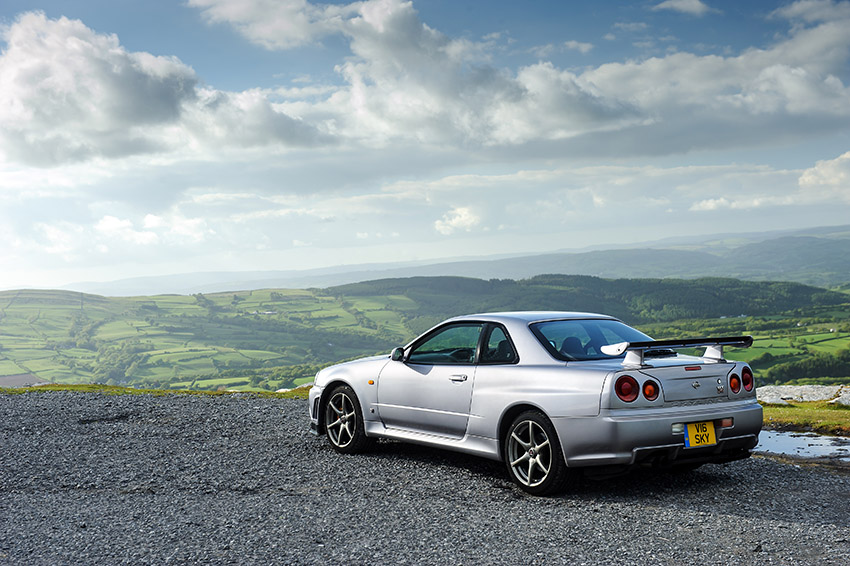
Flaunting Victory
One of the biggest things to note though is the sheer number of special editions that arrived throughout the R34’s lifetime. In fact, they’re so numerous that you’re more likely to spot some sort of special edition, than you are a standard car.
The V-Spec (or ‘victory-spec’, built to celebrate the Skyline’s historic circuit successes) is the first step beyond the base model. Like the R33 V-Spec before it, this edition of the car came equipped with Nissan’s ‘Pro’ variant of the ATESSA-ETS four-wheel drive system. In simple terms, this uses an electronic limited-slip differential to control not only the front and rear torque split, but also the power distribution to the left or right side of the rear axle.
Now, if you’re buying a genuine UK-market car, then you’re guaranteed to get a V-Spec. Nissan shipped just 80 R34s to Britain, all of which the V-Spec variant, and each receiving three extra oil coolers, stiffer suspension, revised ECU, and leather seats. Those in the United States will resort to importing any one of the R34 models built. Sadly for the US market, the R34 GT-R didn’t arrive officially in the late 90’s early 00’s. Therefore, it currently falls short of the 25 year window needed before being legal to import the car into the country. However, you can now buy the earliest examples of its RWD GT-T cousin.
Rare Beasts
Of course, other special editions have been imported since though. These include the plusher M-Spec, racier V-Spec II, and hardcore ‘Nür’ spin-offs of both. A handful of R34s were also built to ‘N1’ spec. These were primarily used for racing in championships such as the Super Taikyu Series.
Then, finally, there’s the Nismo Z-Tune. Considered the ultimate Nissan Skyline GT-R R34, only 20 Z-Tunes were ever built, all atop used donor cars. These mutant R34s boast a larger capacity 2.8-litre version of the RB engine, as well as a plethora of structural pieces made from carbon fiber. Sadly, their scarcity and reputation make them all but unattainable for the average buyer. Despite soaring prices, it is still possible to get your hands on a more typical R34 for less than six figures. Plus, as the car’s getting on a bit now, Americans only have one more year to wait before the earliest examples are exempt from the US’ 25-year import ban.
Wherever you are in the world though, a Nissan Skyline GT-R R34 represents a considerable investment. Here are some of the key things to watch out for when taking the plunge on one.
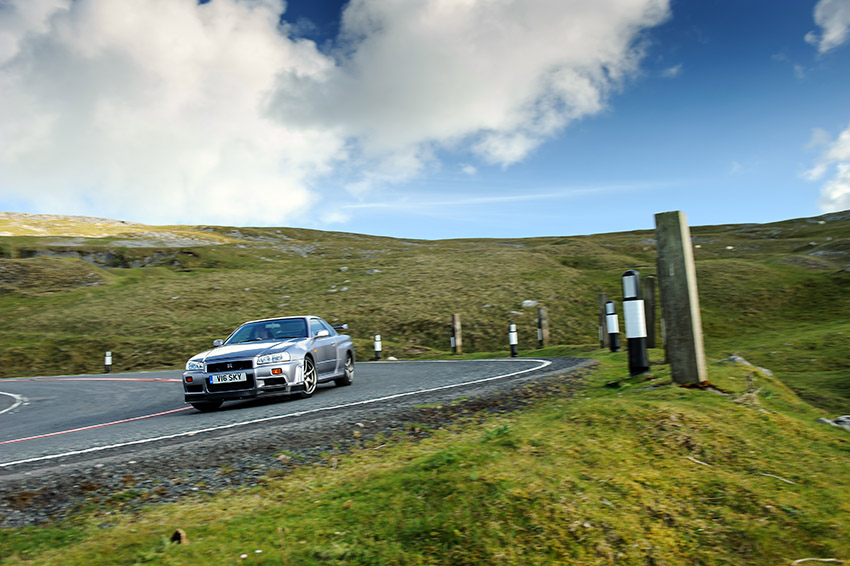
Nissan Skyline GT-R R34 Top 5 common problems
- Fried coil packs
- Split vacuum lines
- Popping out of gear (especially in first)
- Faulty LCD display
- Rust in crevices and recesses
Engine & Transmission
One of the features retained from the R33 GT-R was the now-legendary RB26-DETT power unit. However, the engine wasn’t completely without revision. The twin-turbo set-up, for instance, now used ball-bearing architecture. This decreased spool time, and upped reliability. On the record, Nissan is adamant that despite its fettling, the R34’s power figures remained the same as the previous car. Unofficially, however, it’s common knowledge that figure was realistically around 320hp. A fair chunk more than the 276hp figure specified by Japan’s ‘gentleman’s agreement’ at the time. Despite the increased power, the RB26 block retained its reputation as a tough, reliable engine Naturally, there are still some red flags you’ll want to be wary of.
Keeping On Top Of Servicing
As far as maintenance goes, makes sure that both the timing belt and water pump have been replaced roughly every 50,000 miles. Of course, keeping an eye on the engine’s lubrication is as important as any other car. If you’re able to, peak underneath the red rocker cover and cast your eyes over the scene. If the car has been serviced regularly, it should be pretty clean under there.
As well as the quality of the oil, you’ll also need to check its pressure. This can be done on a test drive quite easily thanks to the car’s Gran Turismo-like display (more on that later). When you take the car above 4000rpm, watch the pressure gauge. If it remains lower than 4.0 bar (58psi), then you’ve got a problem on your hands. Oh, and while you’re behind the wheel, see if you can convince the seller to let you do a hard launch (or demonstrate one to you). If the display shows a 50/50 torque split to the front and rear, then you know your ATESSA-ETS system is working.
Achilles Heels
The weakest point under the bonnet, meanwhile, is the coil pack. Check the car’s history to see if it’s been replaced at any point, and when. If they haven’t been changed recently, factor in a likely bill to switch the coils out in the near future. In addition, vacuum lines have been known to split fairly easily, so have a thorough check over those.
Besides that, the only other causes for concern within the engine bay are likely to be aftermarket parts. If the R34 you’re looking at has some (and it probably will), then be sure that these have been fitted by a reputable tuner, or at least by an owner who truly does know what they’re doing. Things like increased boost pressure and altered ECU settings should be viewed with a critical eye. Quiz the seller to see if any engine mods have been supplemented by measures to keep things reliable.
Parting Thoughts
Like the engine, the R34’s transmission is impressively resilient. That said, check for clutch slip or worn synchromesh. Occasionally, you might even come across an example that pops out of gear. A test drive will answer all these questions for you.
Finally, if you’re willing to pay the sums required to buy a Nissan Skyline GT-R R34, then please do yourself a huge favour and get the car compression tested beforehand. A healthy car is a big enough expense, let alone one that’s in impending need of an overhaul.
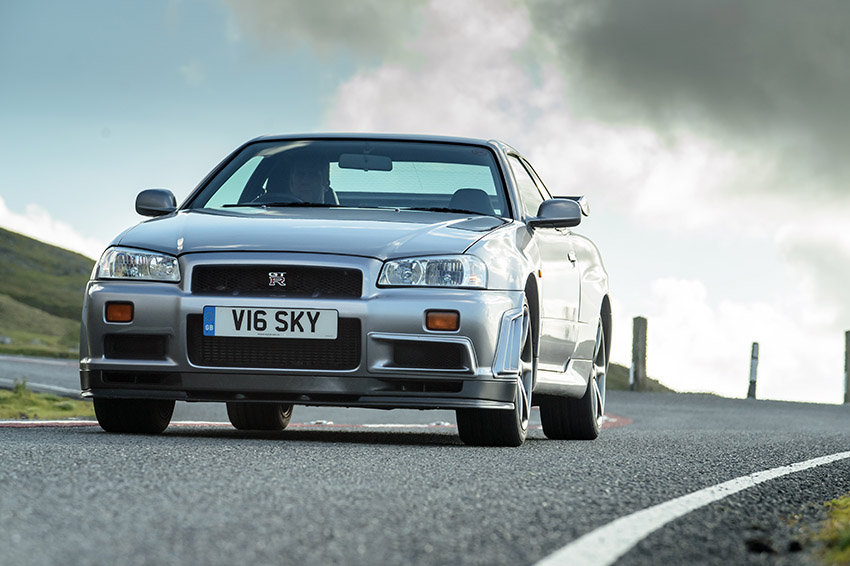
Suspension & Brakes
The suspension could have quite an impact upon which R34 you buy. If you’re happy to sacrifice all-round comfort for precision, get a V-Spec. If, however, a cruiser is what you’re after, the standard base car would suffice.
When having a look around underneath the car, take notice of the state of bushes and ball joints. If they need replacing, it’s not the end of the world. However, costs can mount up if they’re needed across all four corners.
Then, while on a test drive, there’s a few different things to listen out for. Any abnormal rattling, scraping, or clunking will clearly suggest that something’s awry with the car’s underpinnings. Though don’t be put off by a bit of transmission whine – the Getrag six-speed isn’t the quietest even when operating normally. A high-pitched metallic sound, meanwhile, might be evidence of a wheel bearing needing attention.
As for the brakes, the Brembos can be a little noisy as standard, especially if performance pads are added. Plus, if you’re looking at a car that’s been collected and displayed rather than driven, be aware that the brake pistons might have seized if it’s been standing for a long time.
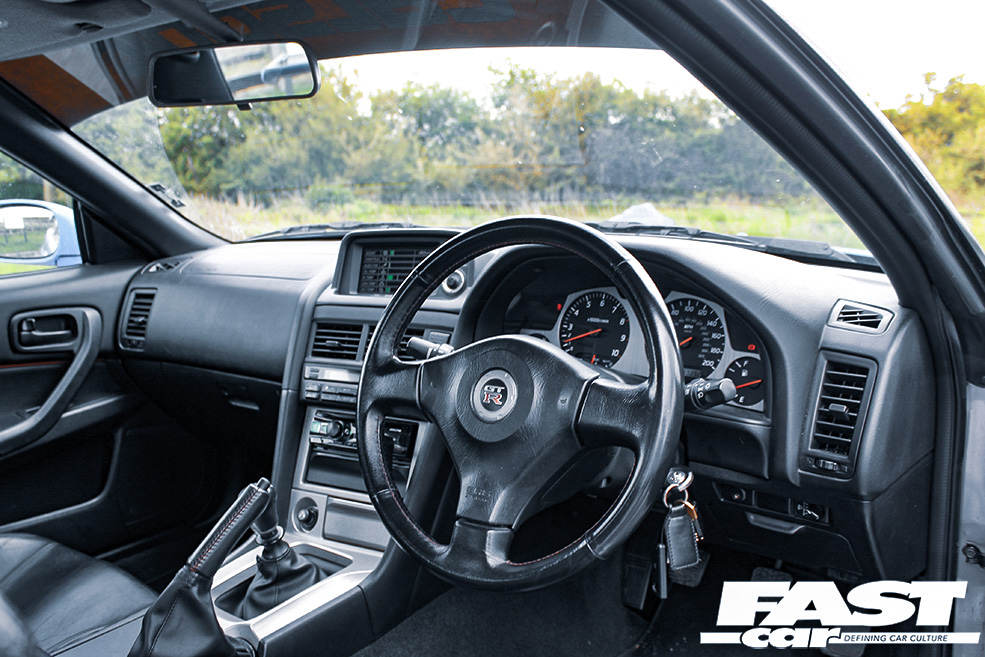
Interior
Onto the inside of the car, and this is where one of the R34’s biggest new features over the R33 comes into play. In the center of the dashboard, the GT-R comes equipped with a 5.8-inch LCD display, designed to give you all of the readings you’d expect from a certain PlayStation racing game. The standard version gives you seven live readouts, while the V-Spec adds intake and exhaust temperatures. As a Nismo optional extra, you could even have a G-Force meter coded into it, and a lap timer that was engaged by a button by the gearstick.
These displays do look cool in a retro sort of way, and if you’re a keen driver, they’re genuinely useful. However, they aren’t bulletproof and sometimes do fail.
Expect wear and tear on the most common contact patches: seats, steering wheel and gearstick. The extent of this can probably tell you a little bit about how the car’s been treated over the years too.
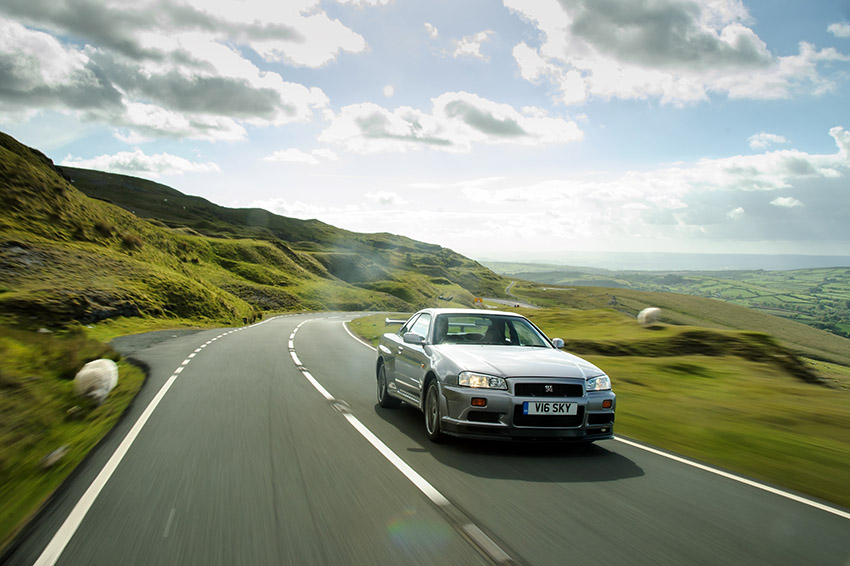
Exterior
You probably don’t need us to tell you that whichever R34 you look at is likely to have been driven pretty hard (unless it’s some sort of museum piece). Naturally, this means it’s likely to have had some sort of minor prang in the past. Check for signs of panel repairs to test the theory, but you shouldn’t necessarily be put off if it has some battle scars. What’s more important is the quality of that repair work. If everything looks quite orderly and precise, you can probably trust it. However, overspray is an easy tell that the repairs might have been a bit more slap-dash.
Speaking of damage, those carbon fiber panels on the underside of the car are likely to have taken some abuse over the past two decades. If they’re in a particularly bad way, be aware that it can cost around a grand to get new ones from Nissan.
Then there’s the issue of rust. Particular problem areas on the R34 include the rear arches and floorpan as you’d expect, and it’s worth checking the sills and chassis rails too. The tops of the struts are another place where corrosion likes to fester, as is the boot lid. Pay attention to any small spots of rust around the rear lights as moisture can pool up in the surrounding crevices.
Tech Specs: Nissan Skyline GT-R R34
Engine: 2568cc straight-six
Max Power: 276bhp at 6800rpm
Max Torque: 295lb ft at 4400rpm
Transmission: six-speed manual
Max speed: 156mph
0-62mph: 4.8 seconds
Weight: 1560kg
Economy: 18.9 mpg

